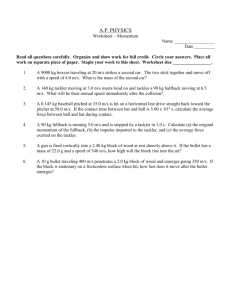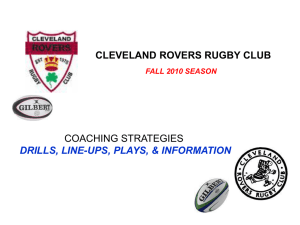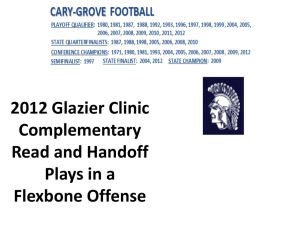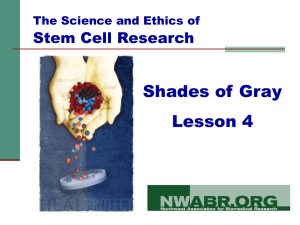fullback, a Novel Posteriorly- Identification and Characterization Expressed
advertisement
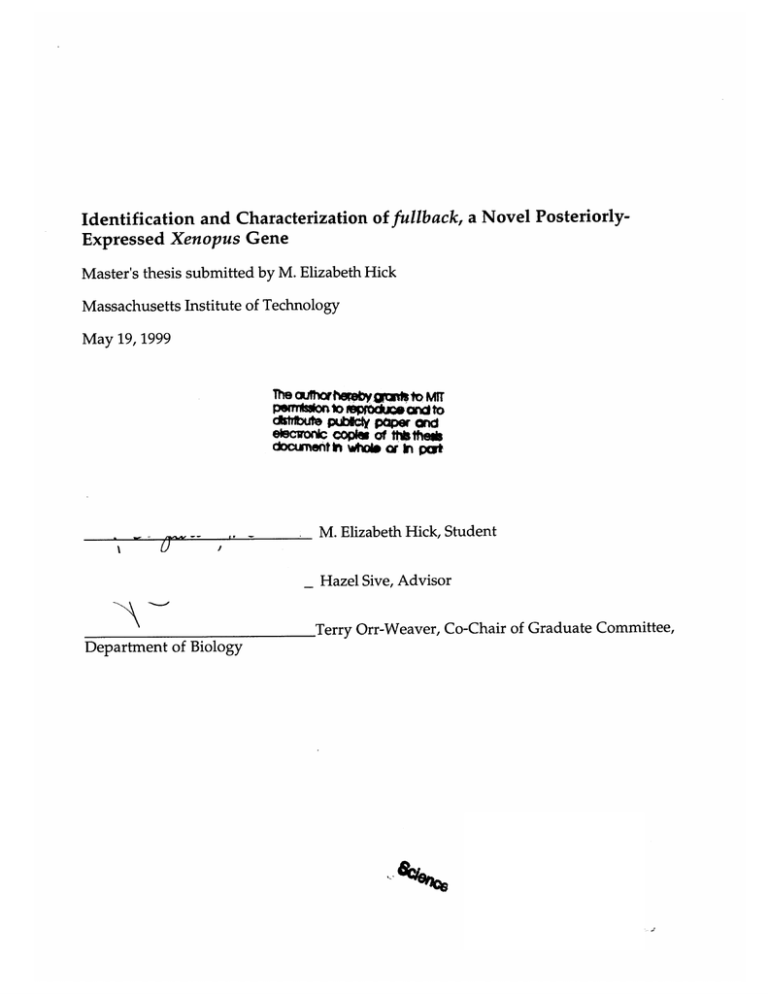
Identification and Characterization of fullback, a Novel PosteriorlyExpressed Xenopus Gene Master's thesis submitted by M. Elizabeth Hick Massachusetts Institute of Technology May 19, 1999 The auwth bebyg itto Mfr prrnIsuiont I o adue ndto dtMaute putcA papr and elcwonic copis of thb the* documtent h whjoI or In part - f-r - - M. Elizabeth Hick, Student Hazel Sive, Advisor Terry Orr-Weaver, Co-Chair of Graduate Committee, Department of Biology MASSACHUSETTS INSTITUTE OF TECHNOLOGY k*168 I-- Abstract: We have identified fullback, a Xenopus laevis gene which shows highest similarity to the low affinity nerve growth factor receptor p75. Extracellular portions of the protein are conserved between fullback and p75, although regions of p75 which have been implicated in its role in apoptosis are not especially conserved in fullback. fullback is expressed in the posterior of the embryo from gastrulation onwards and is found dorsally during tailbud stages. This pattern of expression apparently does not coincide with the incidence of apoptosis in the early Xenopus embryo and therefore indicates that fullback may have a different function during embryogenesis. Results: The low affinity nerve growth factor receptor p75 is a member of the "death receptor" family of transmembrane proteins, most of which have some role in apoptosis (Liepinsh, et al, 1997). This receptor sends a pro-apoptotic signal leading to neuronal death unless it binds a neurotrophic ligand such as NGF which causes it to send an anti-apoptotic signal instead (reviewed in Bredesen and Rabizadeh, 1997). Using a yeast invertase screen to find secreted and transmembrane proteins which may play a role in patterning the early embryo, we have identified fullback, a Xenopus gene with highest similarity to p75 (Jacobs et al, 1997). Here we report a sequence comparison of fullback to p75 in other vertebrates and a spatial and temporal analysis of fullback expression in Xenopus. fullback encodes a 427 amino acid protein with a signal sequence peptide at the amino terminus (von Heijne, 1986) and a single putative transmembrane domain. While the p75 genes from human, rat and chicken share between 75-85% identity with each other, fullback is only approximately 40% similar to any of them and is therefore unclear whether fullback is a Xenopus homolog of p75 (Fig 1). The death receptor family of proteins is characterized by their cysteine-rich extracellular domains (Liepinsh et al, 1997). A protein sequence alignment of fullback with the three p75 proteins illustrates that all 25 of the extracellular cysteines in p75 are also conserved in this region of fullback (Fig 1, boxed). This implies that fullback may have extracellular structural similarity to p75. However, the "death domain", a sixhelix portion of the intracellular domain present in most death receptor family members which is thought to be essential for apoptotic signaling (underlined, Fig 1) (Tartaglia, et al, 1993) is not well conserved in fullback, suggesting that this protein may have an entirely different, non-apoptotic function in the embryo. Northern analysis of fullback expression (Fig 2), shows a full length transcript of approximately 3kb. Weak maternal expression can be detected by RT-PCR (data not shown), but is not apparent by Northern blot. Zygotic expression of fullback begins at midgastrula stages, peaks during neurulation and then declines by swimming tadpole stages. In situ hybridization analysis was performed in order to determine the location of fullback transcripts within the embryo (Fig 3). During gastrula and neurula stages,fullback expression is posteriorly localized. At early gastrula (Fig 3A, panel a) weak expression is found in a wide rim around the blastopore. At midgastrula (panel b)fullback expression remains around the blastopore and increases in intensity. A cross section through a halved embryo of this stage (panel f) shows that fullback is expressed in the superficial tissue of the blastopore lip but not in the involuted mesoderm. At neurulation (panel c)fullback reaches its highest levels of expression and is found in a ring around the closed blastopore in the posterior of the embryo, both in the ectoderm and in the underlying mesoderm (panel g). At this stage, dorsal expression begins to extend out from the posterior of the embryo in a small streak along the midline (arrow, panel c). Cross sections of neurula embryos suggest that this staining does not coincide with the notochord but may correspond to migrating neural crest. At late neurula (panel d) expression persists in the posterior of the embryo and continues to extend dorsally into regions near the developing somites. A comparative in situ done on halved embryos with fullback and m-actin probes clearly shows non-overlapping regions of expression, implying that this dorsal fullback expression is not myotomal (panels h and j). At tailbud stages fullback is maintained in the posterior and the dorsal expression expands ventrally (panel e). A transverse cut through these embryos reveals that the dorsal staining overlaps with muscle actin staining in the somite, implying that at this stage fullback RNA is present in the myotome (panels i and k). In order to assess whether fullback plays a role in modulating apoptosis, we compared its expression with TUNEL assays which profile the temporal and spatial occurrence of apoptosis within the Xenopus embryo (Hensey and Gautier, 1998). Using this assay, these authors found that apoptosis begins at midgastrula stages in a variable pattern including every region of the embryo except the cells immediately surrounding the blastopore. Later, TUNEL staining coincides with regions of neurogenesis in the ectoderm during neurula and tailbud stages. These regions of the embryo do not correspond with those expressing fullback, implying that fullback is not essential for apoptotic signaling. These data, together with the significant intracellular sequence divergence between p75, suggest that the function of fullback is different from that of p75. Methods: The full length clone of fullback was isolated from a random-primed cDNA library made from ventral mesoderm and ectoderm from mid-gastrula Xenopus embryos (stage 11.5). Embryos were staged according to Nieuwkoop and Faber, 1967. Two oligos were used to form an EcoR I adapter: BIS3, 5'AATTCCCATAGCAACAAACAGTA-3', unphosphorylated and BIS4, 5'TACTGTTTGTTGCTATGGG-3', phosphorylated. The random-primed cDNA library was subjected to a yeast selection as described previously (Jacobs et al., 1997). The Genbank accession number of fullback is AF131890. in situ hybridization was performed as described in Kuo, et al., 1998. Most in situ panels show albino embryos, although some show wild type embryos which have been bleached in 2% hydrogen peroxide for 45 minutes. Northern blot analysis was performed as described in Sagerstrom et al., 1997. fullback - -MD KRGM1 IV T hp75 -MG AG A T G R MD G 0!11 1! rp75 MR RAG A ACSM DR LR....R - -MG FV L4L cp75 F KA TEPE ..... fullback hp75 TOG rp75 T'3 cp75 S SES /S S G G IT E - - - aS TP P E .S TP P E H TPS LA 72 79 80 71 :E L SS M - 1,A K. 18 SV S V F E g AE ' .... ... V 111 118 119 110 R SPSLTLESNT fullback S S E S hp75 rp75 F 3 cp75 fullback hp75 rp75 cp75 32 39 40 31 I %I fullback hp75 rp75 cp75 fullback hp75 rp75 cp75 I>1K IS fs L GG LM I'sP X:K S K 151 158 159 150 s P T VQ IG D NE RML R TERQL RH N: E 1V M V K D K D VP PQH RW A PW A A TS I D P --- 191 D L H P WTT 189 - - - - i- - - G - - -m A. lb- VVT T A P S 'Q E IE A P P E Q D L IA S T A S 70 E ;iE V P P E 0 D L V P S .1V WDM V ~E LK E I PG RNI T 197 E I PG RWI P 198 F N T E G MA TT L D VT 203 237 238 226 fullback hp75 rp75 cp75 242 277 278 266 fullback hp75 rp75 cp75 281 317 318 306 fullback hp75 rp75 cp75 -N HLSKAK IEP Q-H T TH T !TA S TA S PPN4S TQ L .L P &P fullback KDO"."Q R1 lis..... ... Y EE'T hp75 D TW RH L AG6ELGY 2 P EH . JPE rp75 D TWRH A .A.? (ED L cp75 EDE fullback hp75 rp75 cp75 Y.IND sH A D TLE qG q s s ( A dif ~.S T; G ED S THEA C S HAC ES CR A3 SK E A TQD AQD A KE 316 356 354 345 356 396 394 385 427 425 416 387 Figure 1: Protein Sequence Alignment of fullback with p75 from Other Vertebrates The p75 proteins shown are from human (hp75), rat (rp75) and chicken (cp75). Identical amino acids are shaded. Numbers to the right of the sequences indicate the numerical positions of the amino acids. Boxes denote cysteines conserved among all four proteins. The six-helix death domain region is underlined and overlined. Gastrula 10 11 Neurula 1I _q 1r fullback rRNA . A 4 %f %w I Figure 2: Northern Analysis of fullback mRNA fullback RNA (upper panel). Lane 1 contains unfertilized egg RNA. Lane 2 contains RNA from early gastrula, stage 10. Lane 3 contains RNA from midgastrula, stage 11. Lane 4 contains RNA from early neurula, stage 13. Lane 5 contains RNA from midneurula, stage 15. Lane 6 contains RNA from early tailbud, stage 22. Lane 7 contains RNA from swimming tadpole, stage 35. 18s Ribosomal RNA is shown in the lower panel as a loading control. - ------------------- Figure 3: In Situ Hybridization Analysis of fullback RNA Expression In situ hybridization was performed on whole (panels a-e) or halved (panels f-k) Xenopus embryos. Dashed lines in panels b-e denote the plane in which each embryo was cut in half. a. Vegetal view of an early gastrula (stage 10.5). b. Posterior view of an embryo at mid-gastrula (stage 11.5). c. Dorsal view of an early neurula (stage 13). Arrow indicates the weakly perceptible stripe of staining at the dorsal midline. d. Dorsal view of a late neurula (stage 18). e. Lateral view of a tailbud (stage 25). f. Interior view of a halved embryo at mid-gastrula (stage 11.5). g. Interior view of an early neurula (stage 13) which has been parasagittally cut in half. h. Interior view of a late neurula halved transversely. The dorsal expression of fullback is shown. i. Interior view of a late tailbud (stage 25) embryo cut transversely in half. Panels j and k: Comparative in situ hybridizations were performed using a probe for muscle actin, which is expressed in the myotome of the Xenopus somite. Panel shows a late neurula embryo (stage 18) cut in half transversely. Panel k shows a tailbud stage embryo (stage 25). In all panels, Vg= vegetal, A= anterior, P= posterior, D= dorsal, V= ventral. j References: Bredesen, D. E., and Rabizadeh, S. (1997). p75NTR and apoptosis: Trk-dependent and Trk-independent effects. Trends Neurosci 20, 287-90. Hensey, C., and Gautier, J. (1998). Programmed cell death during Xenopus development: a spatio-temporal analysis. Dev Biol 203, 36-48. Jacobs, K. A., Collins-Racie, L. A., Colbert, M., Duckett, M., Golden-Fleet, M., Kelleher, K., Kriz, R., La Vallie, E. R., Merberg, D., Spaulding, V., Stover, Williamson, M. J., and McCoy, J. M. J., (1997). A genetic selection for isolating cDNAs encoding secreted proteins. Gene 198, 289-96. Johnson, D., Lanahan, A., Buck, C. R., Sehgal, A., Morgan, C., Mercer, E., Bothwell, M., and Chao, M. (1986). Expression and structure of the human NGF receptor. Cell 47, 545-54. Kaplan, D. R., and Miller, F. D. (1997). Signal transduction by the neurotrophin receptors. Curr Opin Cell Biol 9, 213-21. Kuo, J. S., Patel, M., Gamse, J., Merzdorf, C., Liu, X., Apekin, V., and Sive, H.L. (1998) opl: A Zinc Finger Protein that Regulates Neural Determination and Patterning in Xenopus. Development 125, 2867-2882. Large, T. H., Weskamp, G., Helder, J. C., Radeke, M. J., Misko, T. P., Shooter, E. M., and Reichardt, L. F. (1989). Structure and developmental expression of the nerve growth factor receptor in the chicken central nervous system. Neuron 2, 1123-34. Liepinsh, E., Ilag, L. L., Otting, G., and Ibanez, C. F. (1997). NMR structure of the death domain of the p75 neurotrophin receptor. Embo Nieuwkoop, P., and Faber, J 16, 4999-5005. J. (1967). Normal table of Xenopus laevis (Daudin), 2nd Edition (Amsterdam: North-Holland Publishing Co.). Radeke, M. J., Misko, T. P., Hsu, C., Herzenberg, L. A., and Shooter, E. M. (1987). Gene transfer and molecular cloning of the rat nerve growth factor receptor. Nature 325, 593-7. Sagerstr6m, C. and Sive, H. L. (1997). Northern hybridization analysis. RNA Methods. Krieg, P., ed. Academic Press, pp 83-104. Tartaglia, L. A., Ayres, T. M., Wong, G. H., and Goeddel, D. V. (1993). A novel domain within the 55 kd TNF receptor signals cell death. Cell 74, 845-53. von Heijne, G. (1986). A new method for predicting signal sequence cleavage sites. Nucleic Acids Res 14, 4683-90.
